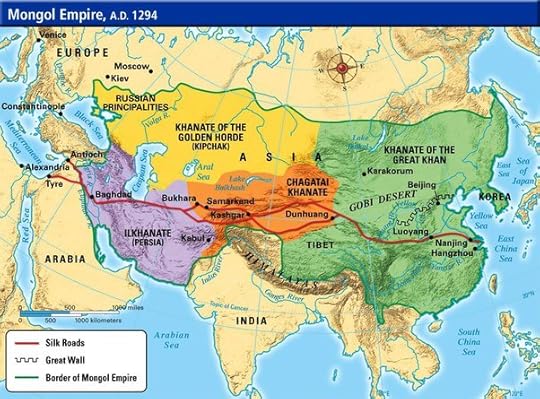The Mongols After 1215

Episode 19 The Mongols After 1215
1215: Years That Changed History
Dr Dorsey Armstrong (2019)
Film Review
Religious tolerance on the part of Mongol leaders greatly facilitated their assimilation of other cultures. Their belief in a “clear blue sky” deity was compatible with most global religions. In fact, each of Genghis Khan’s sons married a Christian woman.
The Mongols were quick to adopt other cultural innovations from the civilizations they conquered. In 1204, Genghis Khan enlisted a Uighur scholar he captured to adopt Turkish script to the spoken Mongolian. He also adopted gunpowder from the Jurchin Jim dynasty, as well as conscripting Chinese engineers to build bridges and siege machines to help him conquer Eastern Europe.
As in they had in the conquest of Beijing, the Mongols frequently burned crops to drive a flood of refugees into overburdened cities. All these strategies combined enabed them to amalgamate Uighurs, Turks, Arabs, Huns, Indians and Chinese for the first time in history.
Five years before his death in 1227, Genghis Khan called a kuritai to approve his plan to divide his empire among his four sons.
His oldest Jochi was given the western empire (bordering modern-day Austria), which became known as the Khanate of the Golden Horded. As he died before Genghis Khan, his lands were divided further among Jochi’s sons.The second oldest Ogitai became the Great Khan and ruled the Middle East region (Ilkhanate)The third oldest Chagatai became ruler of Central Asia (Chagatai Khanate)The youngest Tolui became ruler of the Mongolian homeland and China.*Armstrong blames Ogitai, under whom the empire reached its maximum (with conquest of Georgia, Armenia, Azerbaijan, and eventually Russia, Ukraine, Poland and Hungary), for hastening collapse. She feels he bankrupted the empire by trying to create a Mongol capitol Karakorum on the Central Plains. As the Mongols had always been nomads, this was an artificial city in a region unsuitable for agriculture and remote from major trade routes. Everything, including water had to be transported a great distance into the city.
The Mongols were the first military force to successfully fight a war on two fronts (against Russia and against the Song dynasty south of the Jurchin emperor). It wouldn’t be until World War II that another armed force (the western Allies) did so successfully. .
The mongols won their three year campaign against Russia (1240-42) by using naptha and similar incendiary devices to frighten and distract the Russian horses, by attacking multiple city-states simultaneously (to prevent the Russian princes from forming a successful alliance) and by sending a small contingent of mounted warriors to exhaust out the Russian horses (whose riders wore armor) before unleashing the bulk of their warriors.
Other significant conquests include the sack of Baghdad in 1258, in which Hulagu Khan (son of Tolui) conquered the Abbasid Caliphate and the conquest of India in 1526 by Babur, a great-grandson of Chagatai.
*The Mongols practiced ultimogeniture, in which the youngest son stayed home to look after aging parents and their animals and inherited the family home.
Film can be viewed free with a library card on Kanopy
https://www.kanopy.com/en/pukeariki/watch/video/12392969/12393009
The Most Revolutionary Act
- Stuart Jeanne Bramhall's profile
- 11 followers



